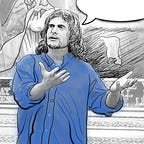Hugo O’Conor — Captain Colorado
At first glance, an Irish officer in the Spanish army might seem unusual but the 18th century was one of great persecution for the Celtic peoples. England had just passed legislation known as The Penal Codes. The sole purpose of these codes was to exterminate the indigenous Celtic culture of Ireland. These codes induced many of Ireland’s finest young men to leave and seek service in the military of their European neighbors. These men, known as “The Wild Geese” were Ireland’s most important export of the age. Several Celtic regiments were formed in the Spanish army including two cavalry regiments — the Dragoons of Dublin and the Dragoons of Edinburgh; and five infantry units; the Irlanda, Hibernia, Ultonia (Ulster), Limerick, and Waterford. One of these men, Hugh O’Conor came to the northern frontiers of Spain’s North American colonies where he became famous as Captain Colorado.
Young Hugh or Hugo was enticed to serve in the Spanish military by his older cousin, Alexander O’Reilly. O’Reilly was fighting a battle in Italy during the Austrian War of Succession when he was severely wounded. An Austrian soldier was looting the battlefield and saw the wounded Irish soldier. The Austrian prepared to finish Alexander off. O’Reilly lied to the enemy soldier, claiming to be the son of a Spanish noble who could be ransomed for great reward if only he could be brought to the tent of the Austrian
Field Marshall. The Austrian Field Marshall was Maximillan Von Browne who despite the name was another Irishman fighting in the army of a foreign country. Von Browne ordered his camp surgeons to doctor up O’Reilly and had him sent back to the Spanish with honor.
O’Reilly welcomed his sixteen year old cousin Hugo O’Conor into the Hibernia regiment of the Spanish army. These regiments of “Wild Geese” in the Spanish army were not only comprised of Irish soldiers but they were commanded by Irish nobles as well. Of all the soldiers in the Hibernia regiment none boasted a more noble lineage than young Hugo O’Conor. O’Conor was descended from the last High King of Ireland, Roderic O’Conor. England had strict laws about the Irish leaving the country to join the armies of other countries and O’Conor faced imprisonment and even execution if caught. Like many others of the time he probably escaped Ireland at midnight, boarding ship on a moonlit night, sneaking from the shore in a tiny curragh.
After serving in a few European campaigns, O’Conor was rewarded by the Spanish king, who granted him knighthood in the Order of Calatrava; a military fraternity whose roots stretched back to the Crusades. In 1763, O’Conor followed his older cousin to the Americas, landing in Cuba and later becoming governor of Texas. The historian Anthony Bonilla wrote of O’Conor’s governorship, “(O’Conor) attained the glorious distinction of leaving an immortal name in the province… and he made himself an object of fear to the savages who knew him by the name El Captain Colorado.” The Apache nickname for the charismatic cavalry commander came from his long red curly hair and beard. “Colorado” is a Spanish word for “red”. O’Conor received his nickname after a battle in Texas. On December 7, 1767, the Irishman and only twenty soldiers battled over three hundred Apache warriors along the shores of the Rio Guadalupe. They fought for over three hours before the Spanish soldiers emerged victorious. O’Conor is believed to have ridden over 10,000 miles on horseback during his defense of Spain’s northern frontier.
On September 10th, 1771 O’Conor was named Commandant Inspector of the Interior Provinces. It was while fulfilling these duties that Captain Colorado led several military campaigns against the Apache and Comanche peoples. It was also during this time that he realigned the string of presidios guarding Spain’s northern frontier. On a hot summer day in August of 1775, Hugo O’Conor signed an order that moved a few dozen soldiers from one tiny remote outpost to build another small garrison slightly north. O’Conor cited his reasons for the move as the abundance of firewood and water at the second sight. Thus the presidio at Tubac was moved only slightly north to a place they named Tucson. It was a decision which did not receive much notice at the time, even O’Conor thought little of it, but the establishment of the presidio is generally recognized as the founding of modern day Tucson.
The shifting of soldiers from Tubac to Tucson was one of several moves orchestrated by O’Conor as he realigned the northern perimeter of Spain’s colonial defenses. Although he signed the orders in August of 1775, the preparations for the move were not completed until February of 1776 and it is this later date which is generally regarded as the birth date of modern day Tucson. O’Conor and the twenty or so soldiers who made the move would probably be incredulous if they could see the modern day southwestern metropolis which Tucson has become.
To help mark the 1994 celebration, descendants of the red captain were tracked down in Ireland and flown to Arizona for the occasion. These descendants were delighted to hear the tales of their illustrious ancestor. The whole thing came as quite a shock to them. It seems that Hugo O’Conor went to his grave without ever mentioning to a soul that he had founded a town named Tucson on the far distant northern perimeter of Spain’s American colonial frontier.
